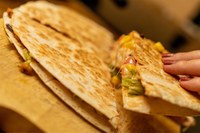Prairie Fare: Try the Food Storage Quiz
(Click an image below to view a high-resolution image that can be downloaded)
By Julie Garden-Robinson, Food and Nutrition Specialist
NDSU Extension
“I had the leftover stuffing for lunch,” my daughter texted.
It was cleverly hidden behind the milk and at the outer limit of its shelf life. Cleaning the refrigerator was on my list.
Therefore, I couldn’t tell her not to eat the “old stuffing.” Fortunately, she was OK.
My family has a love-hate relationship with leftovers. One daughter loves them, and the other one prefers freshly made food. Sometimes, however, she has no choice but to eat reheated leftovers.
Our son used to avoid leftovers until he began living on his own. Now he explores the refrigerator for food. Buying your own food definitely affects your willingness to waste it.
My husband and I eat leftovers almost every day. I make extra food so we have lunch for the next day to save time, effort and money.
Unfortunately, too much food is wasted annually.
According to the Economic Research Service, between 30% and 40% of food is wasted yearly. That amounts to 80 billion pounds of food worth $161 billion. That’s about 219 pounds of food waste for every person.
Along with buying what we can use within a reasonable time, we need to keep safety in mind, too.
How long is fresh food and leftover food “safe” in your refrigerator or freezer? Try this quiz. You can download a free “food keeper” app on your smartphone or visit https://www.foodsafety.gov/keep-food-safe/foodkeeper-app and use the information online.
1. Maintaining food at the proper temperature is key to food safety. At what temperature should you maintain your refrigerator, according to the U.S. Department of Agriculture (USDA)?
a) 35 F
b) 40 F
c) 45 F
2. At what temperature should your freezer be maintained, according to the USDA?
a) minus 5 F
b) 0 F
c) 5 F
3. You bought a turkey to enjoy for the holidays and froze it. For the best quality, within how many months should you use your frozen turkey?
a) 6 months
b) 9 months
c) 12 months
4. You have a frozen turkey in your freezer maintained at the proper temperature. It has been stored frozen for two years. Is it safe to eat?
a) Yes
b) No
5. To save time, you purchased refrigerator cookie dough for the holidays. How long is the dough of high quality and freshness?
a) 4 days from purchase date
b) 7 days from purchase date
c) Consult the use-by date on the package
6. You made a casserole and refrigerated the leftovers. How long is the casserole safe and high quality?
a) 2 days
b) 4 days
c) 7 days
7. You found a can of cranberry sauce that you purchased 18 months ago. Is it safe to use?
a) Yes
b) No
The answers are 1. b; 2. b; 3. c; 4. a; 5. c; 6. b; 7. a.
Most leftover food is good for three to four days after preparation as long as the food was prepared safely and refrigerated promptly. If you will not use leftovers within this time period, consider freezing the food. Frozen food is “safe” for long periods of time, but the quality will decline with time.
Visit https://www.ag.ndsu.edu/food/food-safety/home to learn more about home food safety and visit https://www.ag.ndsu.edu/food/food-preservation/freezing to learn about freezing food for best quality.
Here’s a tasty way to creating something “new” from leftovers.
7 Steps to Making a Quesadilla
- Heat a nonstick frying pan to medium-high heat. Add 1/2 teaspoon of olive or canola oil and spread around frying pan. When the oil is hot, place one whole-wheat tortilla in the pan.
- Sprinkle 1/4 cup of your favorite low-fat shredded cheese, such as mozzarella, Monterey jack or cheddar, over the top of the tortilla, making sure that the cheese does not land on the pan.
- Add 1/2 cup of protein, such as canned beans (drained and rinsed), cooked chicken, turkey, shrimp, shredded pork or beef, or tofu.
- Add 1/2 cup of veggies for flavor, fiber and extra nutrition. Try tomatoes, spinach, mushrooms, bell peppers, corn, onions, avocados or your favorite veggie of choice. Add cilantro, pineapple, hot sauce, jalapenos, black olives or salsa for an additional boost of flavor.
- Sprinkle 2 tablespoons of cheese on top of the fillings and place the other whole-wheat tortilla on top. Cover pan and cook for approximately two to four minutes or until cheese begins to melt and tortilla browns.
- Using a spatula, carefully flip the quesadilla over and cook for approximately two more minutes.
- Cut into six pieces and top with guacamole, salsa and low-fat sour cream or plain or Greek yogurt.
The nutritional value varies depending on the ingredients you choose.
(Julie Garden-Robinson, Ph.D., R.D., L.R.D., is a North Dakota State University Extension food and nutrition specialist and professor in the Department of Health, Nutrition and Exercise Sciences. Follow her on Twitter @jgardenrobinson)
NDSU Agriculture Communication - Nov. 19, 2020
Source: Julie Garden-Robinson, 701-231-7187, julie.garden-robinson@ndsu.edu
Editor: Ellen Crawford, 701-231-5391, ellen.crawford@ndsu.edu




